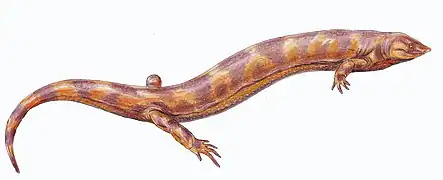| Megamolgophis Temporal range: | |
|---|---|
| Scientific classification | |
| Domain: | Eukaryota |
| Kingdom: | Animalia |
| Phylum: | Chordata |
| Clade: | †Recumbirostra |
| Order: | †Lysorophia |
| Genus: | †Megamolgophis Romer, 1952 |
| Type species | |
| Megamolgophis agostini Romer, 1952 | |
Megamolgophis is an extinct genus of eel-like tetrapod, possibly belonging to the group Lysorophia. Fossils from this genus have been found in the Allegheny mountains of the eastern United States. The genus is endemic to geological formations of this area, such as the Greene and Washington formations of the Early Permian Dunkard Group, as well as the Pennsylvanian (Late Carboniferous) Conemaugh Group.[1][2][3]
If correctly assigned to Lysorophia, members of Megamolgophis would not only be the largest known lysorophians, but also some of the largest lepospondyls in general. In 1952, Alfred Romer suggested that the holotype may have been 1.3 meters (four feet) in length, similar to the length of an average black snake. However, based on the length of the specimen's ribs, Romer also considered it likely that it was much wider and therefore much heavier in life than a black snake, instead being proportionally similar to an eastern diamondback rattlesnake.[1] It is uncertain whether this genus legitimately belongs to Lysorophia, as referred skull material shows notable differences with lysorophian skulls.[3]
See also
References
- 1 2 Romer, Alfred S. (1952). "Late Pennsylvanian and early Permian vertebrates of the Pittsburgh-West Virginia region". Annals of the Carnegie Museum. 33: 47–112.
- ↑ Lucas, Spencer G. (2013-11-01). "Vertebrate biostratigraphy and biochronology of the upper Paleozoic Dunkard Group, Pennsylvania–West Virginia–Ohio, USA". International Journal of Coal Geology. 119: 79–87. doi:10.1016/j.coal.2013.04.007. ISSN 0166-5162.
- 1 2 Wellstead, Carl F. (1991). "Taxonomic revision of the Lysorophia, Permo-Carboniferous lepospondyl amphibians" (PDF). Bulletin of the American Museum of Natural History. 209: 1–90.



